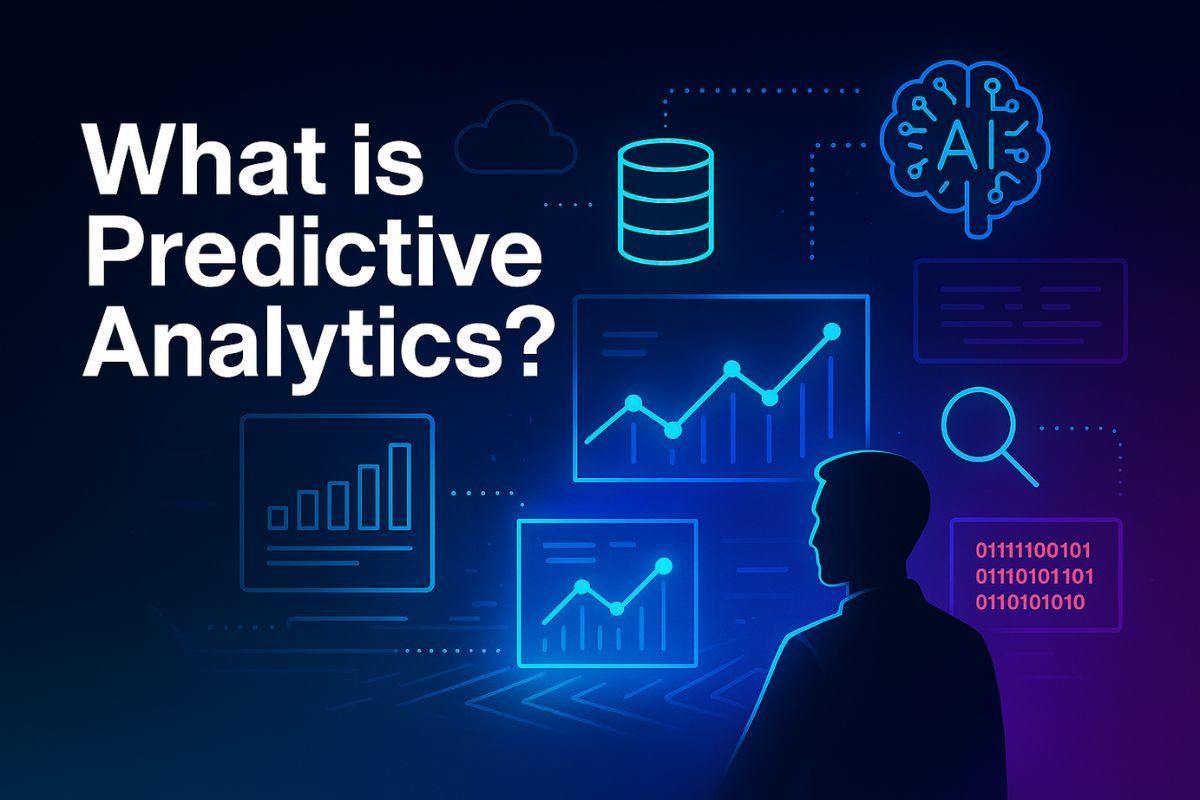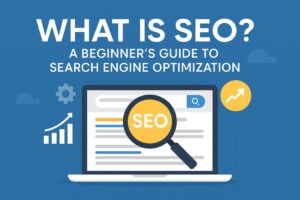Predictive Analytics is a powerful branch of data analytics that uses historical data, machine learning, and statistical algorithms to forecast future outcomes. In this blog, you’ll learn what predictive analytics is, how it works, key tools and techniques, career paths, and how to start your journey in this high-demand field in 2025 and beyond.
In a world driven by data, the ability to predict what’s coming next can give businesses a competitive edge. Enter Predictive Analytics—a transformative technology that’s reshaping how companies make decisions, forecast trends, reduce risks, and deliver personalized customer experiences.
But what exactly is predictive analytics? Why is it important in industries like finance, marketing, healthcare, and cybersecurity? And more importantly, how can you build a successful career in this fast-growing field?
Let’s break it down.
What is Predictive Analytics?
Predictive analytics is a branch of advanced analytics that uses historical data, statistical algorithms, and machine learning techniques to identify the likelihood of future outcomes.
It doesn’t just tell you what happened or why it happened—it predicts what is likely to happen next.
How It Works: A Simple Explanation
- Data Collection: Historical data is gathered (e.g., sales, user behavior, customer feedback).
- Data Cleaning & Processing: The data is organized, structured, and cleaned.
- Model Building: Predictive models are created using techniques like regression, decision trees, and neural networks.
- Forecasting: These models are used to make predictions on new or unknown data.
Applications of Predictive Analytics in Real Life
Predictive analytics is used in nearly every industry:
In Business
- Forecasting sales and revenue
- Predicting customer churn
- Personalizing marketing campaigns
In Healthcare
- Predicting disease outbreaks
- Patient readmission analysis
- Drug response predictions
In Finance
- Fraud detection
- Credit scoring
- Investment risk assessment
In Cybersecurity
- Threat detection and prevention
- Behavior anomaly identification
- Predicting potential data breaches
Key Techniques Used in Predictive Analytics
1. Regression Analysis
Predicts a value based on the relationship between variables (e.g., sales vs. time).
2. Classification Models
Classifies data into categories (e.g., spam or not spam).
3. Time Series Analysis
Forecasts trends based on data collected over time (e.g., stock prices).
4. Neural Networks
Mimics the human brain to identify patterns in large datasets.
5. Decision Trees
Breaks down decisions into a tree-like model for easier interpretation.
Predictive Analytics vs. Other Types of Analytics
| Type of Analytics | Purpose | Example Use Case |
|---|---|---|
| Descriptive Analytics | What happened? | Monthly sales report |
| Diagnostic Analytics | Why did it happen? | Analyzing a sales drop |
| Predictive Analytics | What is likely to happen? | Forecasting next quarter’s sales |
| Prescriptive Analytics | What should we do about it? | Recommending marketing strategies |
Why Predictive Analytics Is a Hot Career in 2025
Predictive Analytics is no longer a “nice-to-have”—it’s a business necessity. Companies are willing to invest heavily in analytics to gain actionable insights.
Job Titles in Predictive Analytics:
- Predictive Analyst
- Data Scientist
- Machine Learning Engineer
- Business Intelligence Analyst
- Risk Analyst
- Marketing Data Analyst
Industries Hiring Predictive Analytics Experts:
- E-commerce & Retail
- Banking & Finance
- Healthcare & Pharma
- IT & Cybersecurity
- Telecom
- Government & Public Sector
Salary Insights for Predictive Analytics Roles in India
| Role | Avg. Salary (INR) |
|---|---|
| Data Analyst | ₹6–8 LPA |
| Predictive Analyst | ₹8–12 LPA |
| Data Scientist | ₹10–18 LPA |
| ML Engineer | ₹12–22 LPA |
| Lead Data Scientist | ₹20–35 LPA+ |
Source: AmbitionBox, Glassdoor, Naukri (2025 estimates)
How to Start a Career in Predictive Analytics
1. Learn the Fundamentals
- Statistics & Probability
- Data Analytics
- Programming (Python, R)
- Machine Learning Basics
2. Master Predictive Tools
- Excel (basic analysis)
- Python (Scikit-Learn, Pandas, NumPy)
- R (Caret, RandomForest)
- SQL (for querying databases)
- Power BI / Tableau (for visualization)
3. Build Projects
- Predict customer churn
- Sales forecasting
- Credit risk prediction
- Fraud detection systems
4. Earn Certifications
- Google Data Analytics Certificate
- IBM Data Science Certificate
- Coursera’s Predictive Analytics Courses
- Microsoft Certified Data Analyst
5. Apply for Internships or Entry-level Jobs
Start small—intern, freelance, or take up junior data analyst roles before jumping into more complex predictive roles.
Tools Used in Predictive Analytics
| Tool / Platform | Use Case |
|---|---|
| Python (Scikit-Learn) | Model building |
| R | Statistical computing |
| RapidMiner | Visual modeling |
| IBM SPSS | Predictive statistical analysis |
| SAS Analytics | Business intelligence |
| Tableau/Power BI | Visualizing predictive outcomes |
Expert Tips to Succeed in Predictive Analytics
- Focus on understanding data before jumping into modeling.
- Don’t just learn tools—understand the business context.
- Continuously upskill with new technologies and algorithms.
- Work on real-world datasets like Kaggle, UCI ML repository, or public government data portals.
- Document your work on GitHub or a portfolio website.
Common Mistakes to Avoid
- Jumping into modeling without proper data cleaning.
- Ignoring model validation (like cross-validation).
- Overfitting the model to training data.
- Not understanding the business problem before building solutions.
- Relying too heavily on automated tools—manual analysis still matters.
Free Resources to Learn Predictive Analytics
- Google Data Analytics Professional Certificate (Coursera)
- Analytics Vidhya
- Kaggle Competitions & Datasets
- UCI Machine Learning Repository
- Towards Data Science on Medium
Conclusion
Predictive analytics is more than a buzzword—it’s a career path full of potential, problem-solving, and high impact. Whether you’re a student exploring data, a professional upskilling for future roles, or someone curious about AI and machine learning, now is the perfect time to get started.
Explore certifications, learn the tools, practice with real datasets, and build a portfolio that demonstrates your analytical thinking.
Your career in Predictive Analytics awaits!
FAQs
1. What is predictive analytics in simple words?
Predictive analytics is a technique that uses historical data to forecast future outcomes using statistics and machine learning.
2. Is predictive analytics the same as data science?
Not exactly. Predictive analytics is a part of data science that focuses specifically on forecasting future events.
3. What are the top tools used in predictive analytics?
Python, R, RapidMiner, IBM SPSS, and Tableau are among the most popular tools.
4. Do I need coding skills for predictive analytics?
Yes, basic programming knowledge (especially in Python or R) is essential to build and run predictive models.
5. Can I learn predictive analytics without a tech background?
Yes, with consistent learning, online courses, and hands-on practice, even non-tech students can master predictive analytics.
6. Which industries hire predictive analysts the most?
Finance, e-commerce, healthcare, cybersecurity, and telecom are top industries using predictive analytics.
7. How long does it take to become a predictive analyst?
With focused learning and project work, you can become job-ready in 6–12 months.



